Are you always pressed for time and do you struggle with finding the time to write blog posts? You will learn how to write blog posts fast in 15 minutes or less without sacrificing the quality of the content.
In the world of blogging, there are two types of people: those who write quickly and efficiently, and those who take their time crafting the perfect post. We have created a separate ultimate guide to writing a blog post where we will show you how to craft a post to perfection.
If you’re someone who wants to create more content faster for your blog, without compromising on the quality of the content then this blog post is for you. We will teach you how to write faster so that you can spend less time writing blog posts and more time in other areas of the business.
Follow these tips for writing fast and you will have a great blog with great content. So let’s get started!

How to Write Blog Posts Fast
I use a well-defined repeatable process to write my blog posts fast. The strategies you find below need to be used together to create content at the fastest possible speed. Here are the strategies I use to write my blog posts fast:
Create a Content Calendar
Deciding what to write can take up more time than the actual writing process.
One of the best ways to write faster is to have a content calendar. This will help you plan your blog posts in advance and it will also allow you to batch your writing.
I recommend using Google Sheets or an Excel spreadsheet to create your content calendar. You can also use Kanban boards like Trello to make your content calendar.
Download Content Calendar Template

Steal our exclusive content calendar template. Have it delivered directly to your inbox:
In a content calendar, you should include the following:
- The topic of the blog post
- The keywords for the blog post
- Any links to articles you can reference
You can also include other information like the word count, publish date, and status in your content calendar.
One of the best ways to come up with content ideas is to do keyword research. Just plug in your main keyword into a keyword research tool and you will get a bunch of related keywords you can write about.
Keyword research is an important part of search engine optimization (SEO) and will ensure you invest time in writing content that people are searching for on Google.
Read our guide Blog Post Ideas & Topic Ideas in 2026 to see the list of all possible blog topics you can write about.
Include both the singular and plural versions of your main keyword when doing your keyword research. For example, if you have a pet blog, just putting the word “dog, dogs” returns more than a million keyword ideas.
The keyword research tool that we recommend is Ahrefs because of the quantity and quality of their keyword data. But it can be extremely expensive if you are on a budget. So we recommend getting an Ahrefs subscription for a month, doing all your research, and then canceling your plan. You can get a few years worth of content ideas, with just a one-month subscription to Ahrefs.
You can mine for keywords by going to Keyword Explorer ❶ in Ahrefs. Enter your seed keyword ❷. Click on Matching terms ❸ to access the list of similar keywords ❹.
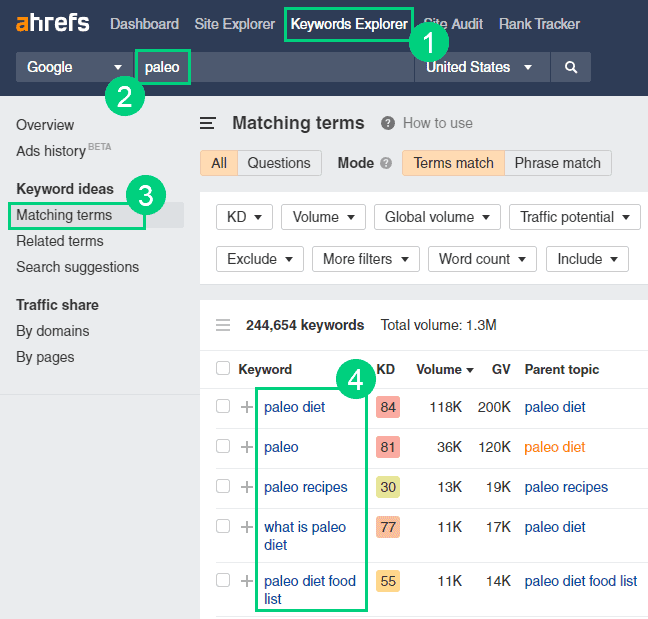
Another budget keyword research tool, that you can use is UberSuggest. There are also free keyword tools you can use like KeywordTool.io that will give you a lot of keyword ideas to get started with.

Research With Timer
The next step is to do your research for the blog post.
Set a timer for 5 to 10 minutes and start researching. The goal here is not to find everything but to find enough.
You can use Google to do your research.
When you’re doing your research, take note of the following:
Identify the Search Intent
Search intent is the goal that the searcher has when they google a particular keyword. What kind of information is the searcher looking for when they search a particular keyword?
You can quickly eyeball the top search results and identify the search intent of your target keyword.
For example, if you take the keyword “dog food for German shepherds”, should you write a post recommending dog food someone can buy in a store, or should you write a recipe to make dog food at home?
You can quickly find what the search intent of a particular keyword is by looking at the articles that are ranking on top of Google for your target keyword. When I google the keyword, I see the top pages are list posts that link to dog food people can purchase for their dogs.

Your article won’t rank unless it satisfies the search intent no matter how good it is.
For example, Ahrefs had the best paid keyword research tool on the planet. But they didn’t rank on the first page of Google for the search phrase “keyword research tool” because people searching that phrase were looking for a free keyword research tool.
But when Ahrefs satisfied the search intent by creating a free keyword research tool that provided 100 keyword ideas for free, they jumped to the top 5 search results.
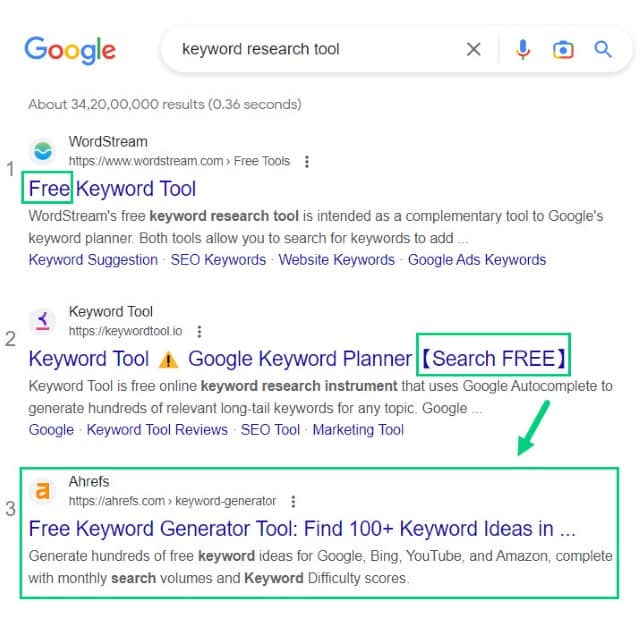
Note Down The Headings
The next step is to quickly go through the top search results and take note of all the headings and sub-headings they use in their articles.
Your article should have similar sections for it to rank well on Google.
Note down these sections in a Word Doc. You can also save links to the pages you see in your research to reference later.
Make a Note of FAQs
Make a note of all the FAQs in the People also asked section in the SERP.
You should answer these questions as sections in your blog post.
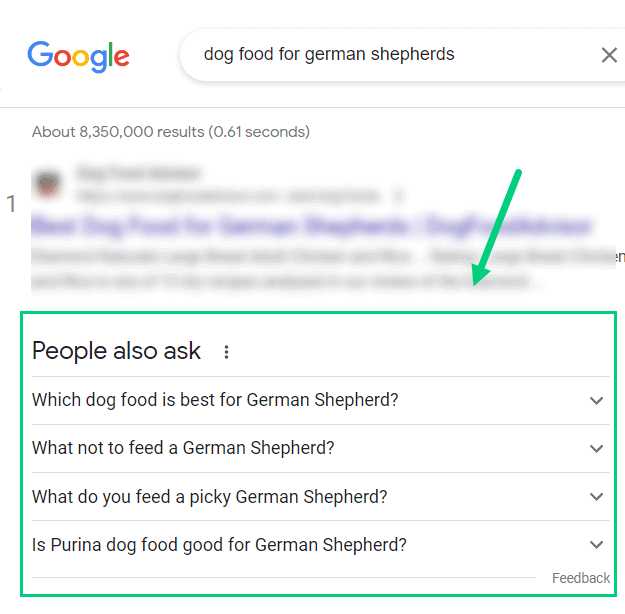
Some of the top search results will also have dedicated FAQs at the end of the blog post. Make a note of these as well.
You will either have to create sections in your article to answer these questions or have a separate FAQ section at the end of the blog post.
Create Outline
Now that you have all the sections, it’s time to quickly create a solid outline for your blog post. Creating a blog post outline is the most important step of the blog writing process.
Your outline should be a simple list of all the sections you want to include in the entire post along with a one or two-sentence description of what each section will cover.
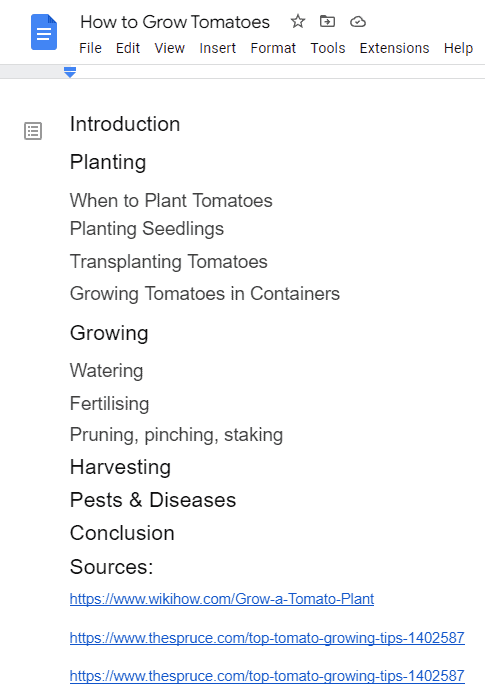
You need to organize the different sections so that there is a logical flow before you write your content.
If you want to create an in-depth article that covers each section of your outline well, then google each section heading and save the links of the top search results under each sub-heading in the outline.
For example, if you are writing an article on “How to Grow Tomatoes”, one of the sub-headings in your article will be “Transplanting Tomatoes. To write this section, you can google this section heading and cover the points in the top search results.
Use a Blog Post Template
If you are creating variations of the same article, you can convert your outline into a content template. This ensures you spend less time on blog writing.
A blog post template is a document with placeholder text that you can use to create similar articles quickly.
Creating blog post templates will eliminate the need to create an outline and research the search intent because you will already have a set structure to work with.
For example, if you want to create a template for Best [Ingredient] Dog Food, your template will have the following sections:
- Introduction
- What is [Ingredient] Dog Food?
- Benefits of [Ingredient] Dog Food
- Best [Ingredient] Dog Food
- Conclusion
You can extend this further by having placeholders for different paragraphs like the introduction and conclusion.
You can now use this “Best [Ingredient] Dog Food” template to write the following articles:
- Best Grain-Free Dog Food
- Best Low-Fat Dog Food
- Best High-Calorie Dog Food
Create an AI First Draft
Once you have the outline ready, it is time to start writing the first draft of your article. You can use AI to write the first draft of your blog post. AI writing tools will not only help you write faster but will also improve your writing.
Most writers face an inertia called writer’s block when they have to sit down to write. AI will help you eliminate the inertia around writing your first draft and you will be able to write a successful blog post super fast.
You can write your new blog post at 5x speed using the AI writing software Jasper. I was able to write over a hundred blog articles in 3 months using Jasper. This blog article you are reading right now was written with the help of Jasper. AI will not only help you write blog posts fast but also with higher quality.
Jasper can write plagiarism-free blog content, articles, social media content, emails, and ad copy. All you have to do is provide a few inputs on what you want and Jasper will do all the hard work of creating the blog content for you. No more writer’s block.
Check out the video below to see Jasper in action:
Try Jasper for free using the links on this page and get 10,000 bonus credits you can use to start writing your first articles.
Once you sign up for Jasper I recommend you spend some time going through the tutorial videos in the Jasper Bootcamp to truly unlock the power of this amazing software.
Check out our guide on How to Write a Blog Post Fast in 15 mins Without Losing Quality for more tips to write fast.
You can write 80% of your article using the AI writing software. All you need to do is provide the outline you created to the AI and it will populate the sub-headings with content.
AI does a good job of writing but is really poor when it comes to doing research. You can look at the links you saved for reference and provide that as a one-line input to the AI.
AI will take your input and expand on it further. It is also really good at writing introductions & conclusions. You just have to give your article title and it will write your introduction and conclusion for you.
AI is capable of writing quality blog posts so it is important to incorporate it into your writing flow. Apart from writing blog content AI can also help you brainstorm a blog post topic and will also help you write social media posts. Use it to write your next blog post.
Create a Human Second Draft
The first draft of your article will not be perfect and that is okay.
You now have a human second draft where you can take the content written by AI and improve on it. Don’t edit while writing. You can do the editing at a later stage.
You can improve the weaker sections of the article by adding more detail or by removing irrelevant information.
You can also rearrange the sections to create a better flow.
The goal is to get all your thoughts down on paper as quickly as possible.
Don’t worry about spelling mistakes, grammar, or even the length of your sentences.
You can fix all of that in the next step.
Edit without Rewriting
The goal of editing is to improve the clarity, conciseness, and flow of your article.
You want to make sure that each sentence adds value and is easy to understand.
You can also use the Hemingway Editor to simplify your sentences.
The Hemingway Editor will highlight all the complex sentences in your article and give you a readability score.
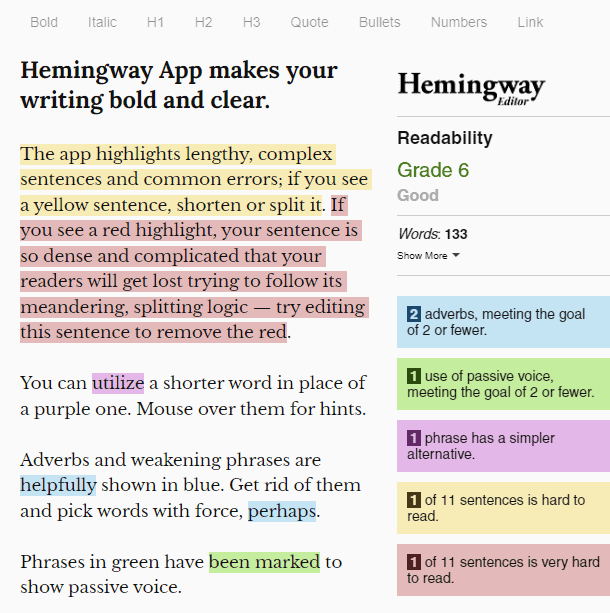
If you see a sentence that is highlighted in yellow or red, try to rephrase it using simpler words and break down long paragraphs into shorter ones.
Your goal is to get the readability score of a 5th or 6th-grader without sacrificing the meaning of your sentences.
Once you are done editing your article on Hemingway, use Grammarly to fix spelling, grammar, and punctuation. Just follow the recommendations and you will be set.

You might have made the AI write the introduction. Now it is time to edit and refine it. You may also want to plugin in your SEO keywords into your intro.
Edit the rest of your post. The effort you put into editing will result in high-quality blog posts.
Use Pomodoro
The Pomodoro Technique is a time management method that can be used to break down work and improve focus.
You can use the Pomodoro Technique to write and edit your article quickly without getting bogged down.
Use a free tool like Pomofocus.io.
Typically Pomodoro uses a 25-minute time interval. But you can set a 35-minute or slightly longer interval to write the article from start to finish. When the time runs out stop writing.

Once you are done, take a 5 to 10-minute break before starting your next Pomodoro.
Using the Pomodoro technique you can eliminate distractions while writing.
Use Headline Template
Once you are done writing your article, it is time to create a blog post title or headline.
You can use a headline template to write an attention-grabbing headline for your article quickly.
A good headline formula will make people want to read your article when they see it in search.
Here are a few headline templates that you can model after:
- How to
[DO SOMETHING](That[GETS DESIRED RESULT])
Example: How to Design a Blog (That People Want to Read) - X Ways to
[Desired Result]in X Days Or Less
Example: 9 Ways to Get More Blog Traffic in 60 Days Or Less - How to
[DO SOMETHING/DESIRED RESULT]without[WORK/SKILL]
Example: How to Get in Shape without Going to the Gym - X Step System for
[GETTING DESIRED RESULT]
Example: 5 Step System for Writing Guest Posts - How to
[GET BENEFIT]by[DOING SOMETHING AGAINST CONVENTIONAL WISDOM]
Example: How to Lose Weight By Eating Fat - X Tips for
[GETTING DESIRED RESULTS]
Example: 10 Tips for Looking 10 Years Younger - How to
[DESIRED RESULT]Like[WORLD-CLASS EXAMPLE]
Example: How to Start an Ecommerce Store Like Amazon [KEYWORD]:[X]Tips You Should Apply Right Now
Example: Blog Design: 5 Tips You Should Apply Right Now- How to
[DESIRED RESULT]When You[SOMETHING CHALLENGING]
Example: How to Write a Blog Post When You’re Busy - The
[LEVEL]Guide to[DESIRED RESULT]
Example: The Beginner’s Guide to Starting a Blog - How to Turn
[BLANK]Into[DESIRED RESULT]
Example: How to Turn Your Clutter Into Cash - The Lazy Person’s Guide to
[GETTING BENEFIT]
Example: The Lazy Person’s Guide to Getting in Shape
Use Dictation Software
If you want to write your article even faster, you can use dictation software. Your writing speed will be equal to your talking speed and you will be able to churn out blog posts quickly.
Dictation software allows you to speak your thoughts and have them transcribed into text helping you speed up content creation.
You can then edit the text to improve clarity and conciseness.
The modern version of Microsoft Word has a dictation software built in. Select the paragraph you want to read ❶. Click Review ❷ and then Speak ❸.
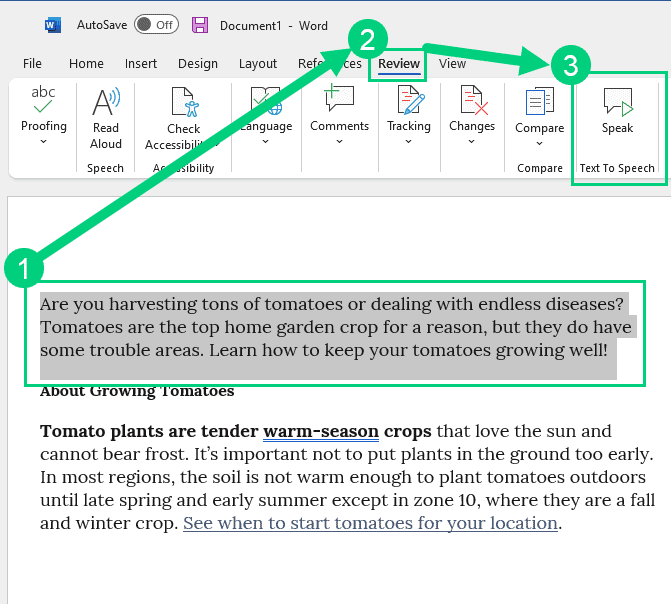
You can also use the dictation feature on your phone or computer. Both Apple and Android have decent dictation features built into their operating systems.
Outsource to a Writer
If you are still not happy and want to write blog posts faster then the last option is to outsource the writing to a freelancer writer. If you don’t have the time to write the article yourself, you can do this and spend no time writing.
There are many sites where you can find writers, such as Fiverr, Upwork, and Freelancer.com.

Create a content brief that has the outline, word count, blog posts, and articles to use as references.
If you have any editorial guidelines, also make sure you share that with your writers so they write a great post.
Just be sure to give clear instructions on what you want the article to be about. The more specific you are, the better the article will be. Make them write one blog post for you and give them feedback before giving them more work.
What Next?
Writing a blog post doesn’t have to be a long and arduous process. Follow these tips to write a blog post faster with higher quality and efficiency.
Now that you know how to write a blog post fast, it is time to put your new skills to the test.
Start by creating a content calendar and scheduling out when you will write your articles.
Writing the perfect blog post need not take time when you know the process of writing. Use the writing tips in this article to write blog posts quickly and create content faster.
Share this post with your friends & followers:
